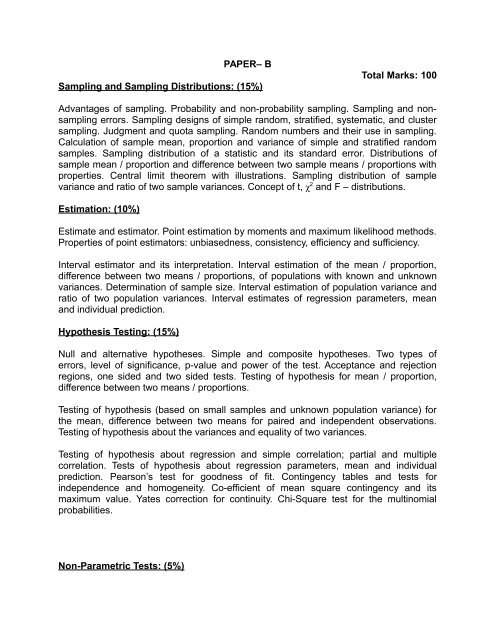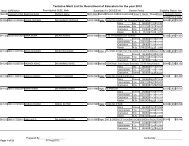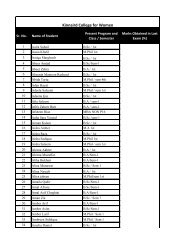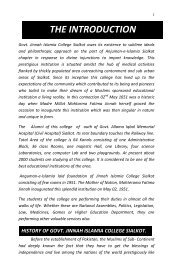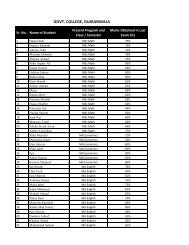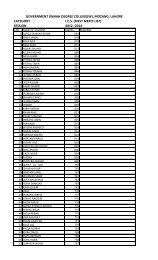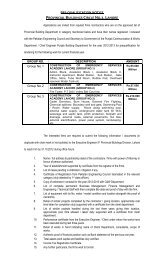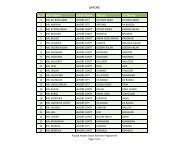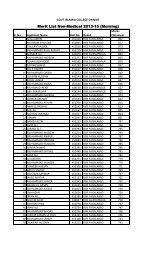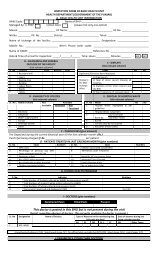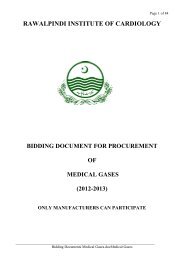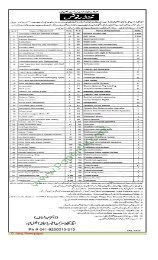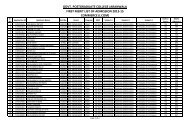syllabus for the subject of veterinary science - Punjab Public Service ...
syllabus for the subject of veterinary science - Punjab Public Service ...
syllabus for the subject of veterinary science - Punjab Public Service ...
Create successful ePaper yourself
Turn your PDF publications into a flip-book with our unique Google optimized e-Paper software.
PAPER– BSampling and Sampling Distributions: (15%)Total Marks: 100Advantages <strong>of</strong> sampling. Probability and non-probability sampling. Sampling and nonsamplingerrors. Sampling designs <strong>of</strong> simple random, stratified, systematic, and clustersampling. Judgment and quota sampling. Random numbers and <strong>the</strong>ir use in sampling.Calculation <strong>of</strong> sample mean, proportion and variance <strong>of</strong> simple and stratified randomsamples. Sampling distribution <strong>of</strong> a statistic and its standard error. Distributions <strong>of</strong>sample mean / proportion and difference between two sample means / proportions withproperties. Central limit <strong>the</strong>orem with illustrations. Sampling distribution <strong>of</strong> samplevariance and ratio <strong>of</strong> two sample variances. Concept <strong>of</strong> t, χ 2 and F – distributions.Estimation: (10%)Estimate and estimator. Point estimation by moments and maximum likelihood methods.Properties <strong>of</strong> point estimators: unbiasedness, consistency, efficiency and sufficiency.Interval estimator and its interpretation. Interval estimation <strong>of</strong> <strong>the</strong> mean / proportion,difference between two means / proportions, <strong>of</strong> populations with known and unknownvariances. Determination <strong>of</strong> sample size. Interval estimation <strong>of</strong> population variance andratio <strong>of</strong> two population variances. Interval estimates <strong>of</strong> regression parameters, meanand individual prediction.Hypo<strong>the</strong>sis Testing: (15%)Null and alternative hypo<strong>the</strong>ses. Simple and composite hypo<strong>the</strong>ses. Two types <strong>of</strong>errors, level <strong>of</strong> significance, p-value and power <strong>of</strong> <strong>the</strong> test. Acceptance and rejectionregions, one sided and two sided tests. Testing <strong>of</strong> hypo<strong>the</strong>sis <strong>for</strong> mean / proportion,difference between two means / proportions.Testing <strong>of</strong> hypo<strong>the</strong>sis (based on small samples and unknown population variance) <strong>for</strong><strong>the</strong> mean, difference between two means <strong>for</strong> paired and independent observations.Testing <strong>of</strong> hypo<strong>the</strong>sis about <strong>the</strong> variances and equality <strong>of</strong> two variances.Testing <strong>of</strong> hypo<strong>the</strong>sis about regression and simple correlation; partial and multiplecorrelation. Tests <strong>of</strong> hypo<strong>the</strong>sis about regression parameters, mean and individualprediction. Pearson’s test <strong>for</strong> goodness <strong>of</strong> fit. Contingency tables and tests <strong>for</strong>independence and homogeneity. Co-efficient <strong>of</strong> mean square contingency and itsmaximum value. Yates correction <strong>for</strong> continuity. Chi-Square test <strong>for</strong> <strong>the</strong> multinomialprobabilities.Non-Parametric Tests: (5%)


